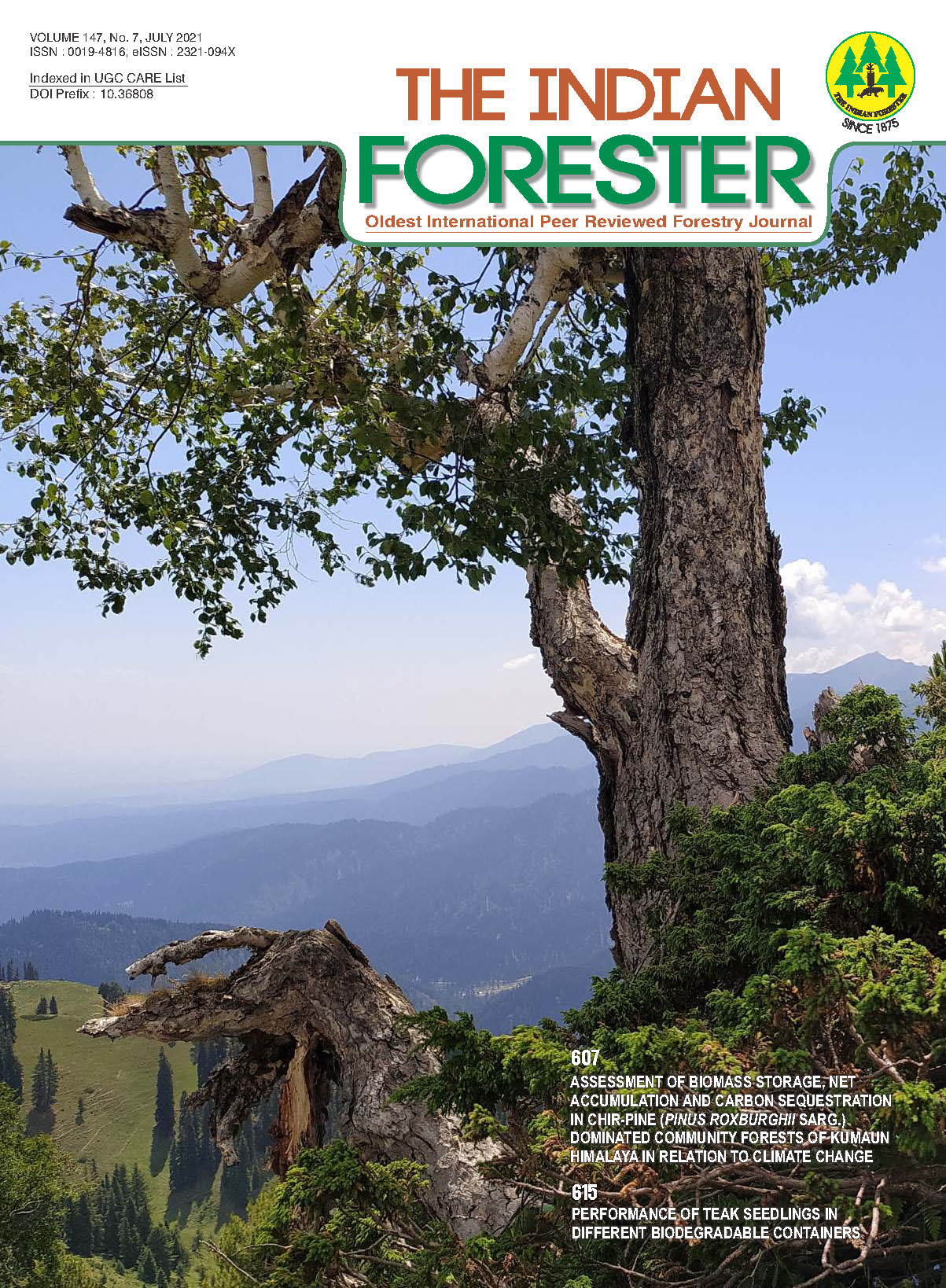Extraction, Utilization Pattern and Prioritization of Fuel Resources for Conservation in Hydro-electric Power Project Areas in Kullu District, Himachal Pradesh, Northwestern Himalaya
DOI:
https://doi.org/10.36808/if/2021/v147i7/147988Keywords:
Fuelwood, Probability of Use (PU), Resource Use Index (RUI), Conservation Prioritization, Hydro-Electric Power Projects, Northwestern Himalaya.Abstract
In hilly areas, fuelwood is the major source of the energy and it provides almost all of the cooking energy requirements. There are millions of people living inside the protected and unprotected areas with dependencies on these areas for essential services. Among these, fuelwood and fodder are two important and critical components of the village economy especially in the hills and the annual wood consumption is very high. Information on fuelwood resources, their extraction and availability are very scanty. Therefore, the present study was carried out to study the diversity of fuelwood species, annual collection, preference, and availability of fuel species in the forests. Forty six species (33 Trees and 13 Shrubs) were extracted for fuel by the inhabitants. Species preference ranged from 0.05-0.55 Probability Use (PU) and was highest for Cedrus deodara (0.55), followed by Picea smithiana, Pinus wallichiana and Quercus leucotrichophora (0.50, each), Alnus nitida, Quercus floribunda and Ulmus wallichiana (0.45, each) and Ulmus villosa (0.40). Use pressure ranged from 1.35-826.65 Resource Use Index (RUI and was highest for Cedrus deodara (826.65), followed by Picea smithiana (675.00), Quercus leucotrichophora (630.00), Pinus wallichiana (558.00) and Quercus floribunda (348.30). Therefore, immediate actions are suggested to sustain the current and future demand for fuelwood. Awareness among the villagers and mass multiplication through conventional and in-vitro methods for the species facing high anthropogenic pressures and their establishment and maintenance in the in-situ and ex-situ conditions may help in the conservation and management of these species.References
Aswal B.S. and Mehrotra B.N. (1994). Flora of Lahaul-Spiti (A Cold Desert in North-West Himalaya). Bishen Singh Mahendra Pal Singh, Dehradun.
Chang X.L., Liu X. and Zhou W. (2010). Hydropower in China at present and its further development. Ener., 35(11): 4400-4406.
Chettri N. and Sharma E. (2006). Assessment of natural resources uses patterns: a case study along a trekking corridor of Sikkim Himalaya, India. Res. Ener. Dev., 3(1): 21-34.
Chettri N., Sharma E., Deb D.C. and Sundriyal R.C. (2002). Effect of firewood extraction on tree structure, regeneration and woody biomass productivity in trekking corridor of the Sikkim Himalaya. Mount. Res. Dev., 22: 150-158.
Chhetri D.R., Basnet D., Po Fonf C., Kalikotay S., Chhetri G. and Parajuli S. (2005). Current status of ethnomedicinal plants in the Darjeeling Himalaya. Curr. Sci., 89(2): 264-268.
Collett H. (1902). Flora Simlensis. Thacker Spink. and Co. Calcutta and Shimla, Reprinted 1971. Bishen Singh Mahendra Pal Singh, Dehradun. pp. 652.
Dhaliwal D.S. and Sharma M. (1999). Flora of Kullu District (Himachal Pradesh). Bishen Singh Mahendra Pal Singh, Dehradun. pp. 744.
Millennium Ecosystem Assessment (MEA) (2005). Ecosystems and Human Wellbeing: Biodiversity Synthesis. World Resources Institute, Washington, DC.
Negi A.K. and Todaria N.P. (1993). Fuelwood evaluation of some Himalayan trees and shrubs. Ener., 18(8): 799-801.
Rai Y.K., Chettri N. and Sharma E. (2002). Fuelwood value index of woody tree species from forests of Mamlay watershed, South Sikkim, India. For. Trees Liveli., 12: 209-219.
Rana M.S. Rana, S.B. and Samant S.S. (2012). Extraction, Utilization Pattern and Prioritization of Fuel Resources for Conservation in Manali Wildlife Sanctuary, Northwestern Himalaya. J. Mt. Sci., 9: 580–588.
Samant S.S., Dhar U. and Palni L.M.S. (1998). Medicinal Plants of Indian Himalaya: Diversity Distribution Potential Values. GyanodayaPrakashan, Nainital. pp. 163.
Samant S.S., Dhar U. and Rawal R.S. (2000). Assessment of fuel resource diversity and utilization patterns in Askot Wildlife Sanctuary in Kumaun Himalaya, India for conservation and management. Env. Cons., 27(1): 5-13.
Saxena A.K. and Singh J.S. (1982). A phytosociological analysis of woody species in forest communities of a part of Kumaun Himalaya. Veget. 50: 3-22.
Schippmann U., Leaman D.J. and Cunningham A.B. (2002). Impact of cultivation and gathering of medicinal plants on biodiversity: global trends and issues. In: biodiversity and ecosystem approach in agriculture, forestry and fisheries: satellite event on the occasion of the ninth regular session of the commission on genetic resources for food and agriculture. FAO, Rome.
Sharma P. (2013). Ecological assessment of floristic diversity and possible impacts of hydropower projects in Kullu District of Himachal Pradesh, North Western Himalaya. Thesis submitted to Kumaun University, Nainital. pp. 411.
Sharma P., Patti P. and Agnihotry A. (2013). Ethnobotanical and Ethnomedicinal Uses of Floristic Diversity in Murari Devi and Surrounding Areas of Mandi District in Himachal Pradesh, India. Pak. J. of Biol. Sci., 16: 451-468.
Singh S., Kothari A. and Pande P. (1990). Directory of National Parks and Sanctuaries in Himachal Pradesh, Management Status and Profiles. Environmental Studies Division, Indian Institute of Public Administration, New Delhi.
Singh S.K. and Rawat G.S. (2000). Flora of Great Himalayan National Park, Himachal Pradesh. Bishen Singh Mahendra Pal Singh, Dehradun. pp. 304.
Srivastava R.K. (2002). Invasion of exotic weeds in the natural forest of tropical India due to forest fires: A threat to Biodiversity. IFFN. No. 27-July, 90-92.
Sundriyal R.C. and Sharma E. (1996). Anthropogenic pressure on tree structure and biomass in the temepetate forest on Manalay Watershed in Sikkim. For. Eco. And Mangmnt. 81: 113-134.
Downloads
Downloads
Published
How to Cite
Issue
Section
License
Unless otherwise stated, copyright or similar rights in all materials presented on the site, including graphical images, are owned by Indian Forester.





